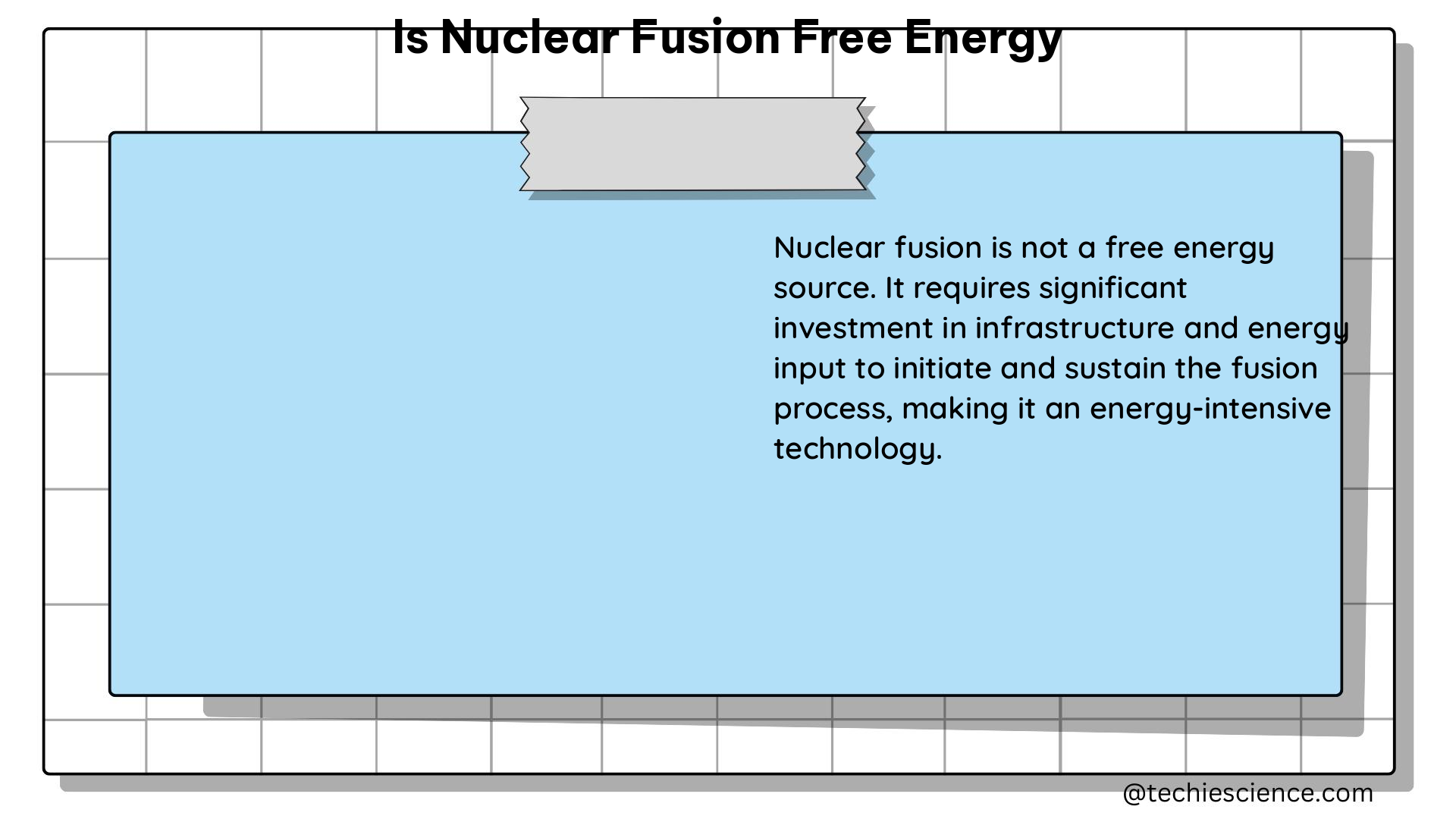Nuclear fusion has the potential to be a free energy source, but it is not currently a free energy source due to the high cost of developing and building fusion reactors. The main challenge is to achieve a rate of heat emitted by a fusion plasma that exceeds the rate of energy injected into the plasma. The most promising designs for fusion reactors are tokamaks and stellarators, which confine a deuterium-tritium plasma magnetically.
The ITER Project: Towards Net Energy Production
The ITER project, an international collaboration to build a fusion reactor in the south of France, is a prime example of the efforts to develop fusion energy. ITER is designed to produce net energy, where the total power produced exceeds the power required to heat the plasma, and to test the integrated technologies, materials, and physics regimes necessary for the commercial production of fusion-based electricity. The collaborators launched the joint experiment in 1985, and the reactor is expected to begin operation in 2025.
Key Specifications of the ITER Project
- Fusion Fuel: Deuterium-Tritium Plasma
- Plasma Volume: 840 cubic meters
- Magnetic Field Strength: 5.3 Tesla
- Plasma Current: 15 million Amperes
- Heating Power: 73 Megawatts
- Estimated Fusion Power Output: 500 Megawatts
The ITER project aims to demonstrate the feasibility of fusion power as a viable energy source by achieving a significant milestone: producing more energy from the fusion reactions than the energy required to heat the plasma.
The National Ignition Facility (NIF): Laser-Driven Fusion

Another example of fusion energy research is the National Ignition Facility (NIF) in the United States, which uses lasers to heat and compress a small pellet of hydrogen fuel to the point where nuclear fusion occurs. NIF has achieved some significant milestones, such as generating more energy from fusion reactions than the energy absorbed by the fuel, but it has not yet achieved “ignition,” where the fusion reactions release more energy than the lasers input.
Key Achievements of the NIF
- Achieved Fusion Yield of 1.35 Megajoules
- Produced More Fusion Energy than Laser Energy Absorbed by the Fuel
- Demonstrated the Feasibility of Laser-Driven Inertial Confinement Fusion
The NIF experiment has provided valuable insights into the physics of laser-driven fusion and the challenges involved in achieving ignition, which is a crucial step towards realizing the potential of fusion energy.
The Physics of Nuclear Fusion
The fundamental challenge in nuclear fusion is to overcome the electrostatic forces that repel the positively charged nuclei from each other, allowing them to get close enough together for the attractive nuclear force to take over and cause the nuclei to fuse together. This can be achieved by heating the fuel to high temperatures, causing the ions to move faster and eventually reach speeds high enough to bring the ions close enough together. The energy released by the fusion reactions can then be harnessed to generate electricity.
The Lawson Criterion
One of the most important theorems in nuclear fusion is the Lawson criterion, which states that in order to achieve net energy gain in a fusion reactor, the product of the plasma density and confinement time must exceed a certain value. This value depends on the temperature and reaction cross-section of the fusion fuel.
The Lawson criterion can be expressed mathematically as:
n * τ ≥ 10^20 s/m³
Where:
– n is the plasma density (in particles per cubic meter)
– τ is the plasma confinement time (in seconds)
Achieving the Lawson criterion is a crucial step in realizing the potential of fusion energy, as it ensures that the fusion reactions release more energy than the energy required to heat and confine the plasma.
Challenges and Ongoing Research
Despite the significant progress made in fusion energy research, there are still several challenges that need to be overcome before nuclear fusion can become a commercially viable and free energy source:
-
Plasma Confinement and Stability: Maintaining a stable and well-confined plasma is essential for achieving the high temperatures and densities required for fusion reactions. Instabilities in the plasma can lead to energy losses and disruptions, which can damage the reactor components.
-
Materials and Engineering: The extreme conditions inside a fusion reactor, such as high temperatures, intense neutron fluxes, and corrosive plasma, pose significant challenges for the materials and engineering of the reactor components. Developing materials that can withstand these conditions is crucial for the long-term operation and reliability of fusion reactors.
-
Cost and Scalability: The construction and operation of fusion reactors are currently very expensive, making it difficult to achieve the economies of scale necessary for commercial viability. Ongoing research aims to develop more cost-effective and scalable fusion reactor designs.
-
Tritium Fuel Cycle: Tritium, one of the fusion fuels, is a radioactive isotope that is difficult to produce and handle. Developing a reliable and sustainable tritium fuel cycle is essential for the long-term operation of fusion reactors.
Researchers around the world are actively working to address these challenges through various experimental and theoretical studies, as well as the development of advanced computational models and simulation tools. The progress made in fusion energy research, exemplified by projects like ITER and NIF, suggests that nuclear fusion has the potential to become a free and sustainable energy source in the future, but significant technological and economic hurdles remain to be overcome.
References:
- Fusion Energy: A Review of the Status of Power Production
- How Today’s Fusion Breakthroughs Could Lead to Breakthroughs in Renewable Energy
- Nuclear Fusion Power
- Fusion Energy
Hi…I am Ankita Biswas. I have done my B.Sc in physics Honours and my M.Sc in Electronics. Currently, I am working as a Physics teacher in a Higher Secondary School. I am very enthusiastic about the high-energy physics field. I love to write complicated physics concepts in understandable and simple words.